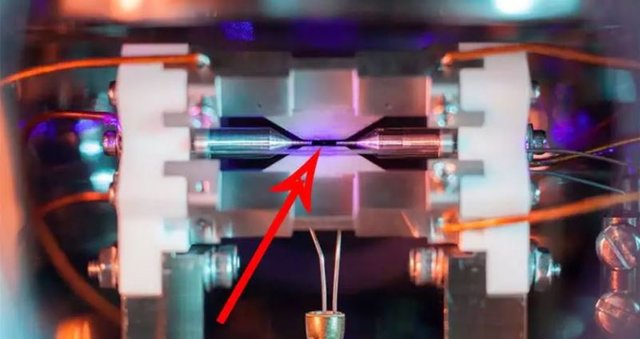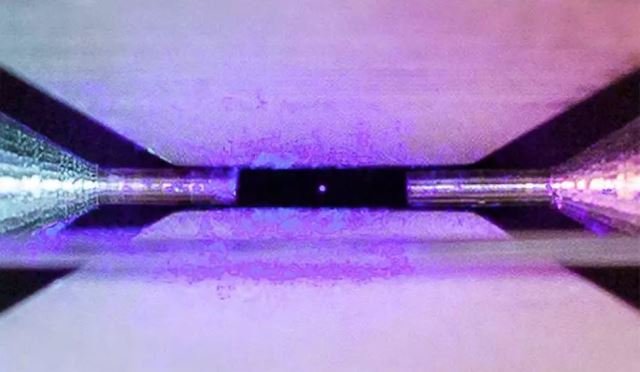Atom Photo Caught By Ordinary Camera Wins A Science Photo Contest

What is an atom? 😁😁
I remember my school days when the answer to the above question was more or less a musical rhyme.
What’s special about atoms?
Well atoms, their chemical significance and study have been a fundamental and core aspect of chemistry, and there are over 109 different types of atom.
By the way;
An atom is the smallest unit of matter that has the properties of an element.
Being the smallest unit of a chemical matter of chemical element, chemistry students were made to believe that atoms could not be seen with the naked eye.
Why can’t we see atoms?
Well, first of all, our eyes aren’t microscopic in nature. There’s a limit to our level of visualization with our organ of sight. Secondly, atoms are “the smallest unit of matter”. So, ideally, it would be near impossible to easily see it with the naked eye
However, that theory has recently gone kablooey. Reason being that a photo of an atom what recently caught by a camera. Yes, a camera! Not a microscope.
What are the properties of an atom?
The chemical nature of atoms make them exhibit different properties which include;
- Atomic number, which indicate the number of protons an atom possesses
- Atomic mass, which indicates the number of protons and electrons an atom possesses
- Radioactivity, the change of the nucleus which can yield rays
- The moles of atoms
- The molar atomic mass……..and others.
A Single Atom in an Ion Trap
Amazingly, a photo taken in a lab at Oxford University by David Nadlinger has negated earlier assumptions about the visibility of an atom. The photo of the single strontium atom, titled “Single Atom In An Ion Trap” which was caught by the Oxford student, was large enough to be seen without a microscope as it was floating in an electric field.

The photograph won David Nadlinger a top prize at a science photo competition at the 2018 Engineering and Physical Sciences Research Council.
How the shot was taken
David Nadlinger embarked on the historical shot by;
- using two metal electrodes
- spacing the two electrodes apart
- holding the strontium atom with the electrodes, almost motionless
On the choice of atom, Nadlinger picked strontium atom as result of its size. The strontium atom has a diameter of few millionth of a millimeter and is composed of 38 protons. The strontium atom was then blasted with lasers.
The atoms were blasted with lasers which made them shine brighter. The laser blast makes the electrons that are orbiting the atom to be more energized. On some occasions, the electrons which get energized give off enough light to make them visible for the atom to be captured by a camera. But even when the atom is visible, it might still be difficult to see it, unless one is looking closely.
In the case of the atom photo, Nadlinger had to take the shot via a long exposure shot from a regular camera.
Why is the atom shot cool?
The atom visualization is linked to quantum theories which are among the most successful theories of nature. Nadlinger speaking on his picture said;
“The idea of being able to see a single atom with the naked eye had struck me as a wonderfully direct and visceral bridge between the minuscule quantum world and our macroscopic reality.”
Summary
The quantum theory and field is quite a complicated one to even to most astute and established physicists, scientists and philosophers.
A lot is yet to be understood about quantum physics, energy, fields and mechanics; as some scientific journals suggest that the best of scientific minds are yet to arrive at a consensus on what the quantum theory says of our world.
The confusion has even raised questions as to ‘what do we really know’ and ‘how sure are we of the things we are sure of’ – it all sounds twisted like an earpiece in a trouser pocket, I know.
But then, as of today, we have realized that we can see an atom, without a microscope, and photographs such as David Nadlinger’s would keep us longing for more answers on what we think we already know when it comes to quantum sciences.
Reference:
en.wikibooks.org
www.epsrc.ac.uk
www.chem.ualberta.ca
nationalpost.com
petapixel.com
www.abc.net.au
Thank you for your time and for reading my post.
If you found this post interesting, then kindly UPVOTE, RESTEEM and FOLLOW @rickie, for more quality posts.
You Can Check Out My Other Posts Below:
- Scientists have established the link between Alcohol, Brain Activity and Aggression
- The World’s Largest Virtual Power Plants – Australia, Tesla and Elon Musk
- Ice-Surface Mechanism and Technique in Winter Games
- A future without traffic delays is now possible with Drone Taxis
- Facial Recognition Technology: China's FR System Aiding the Arrest of Criminals
- The Science of DNA Extraction, and the use of Sodium

This really great. Although am not a science person but av heard of atom, smallest mollecules or thereabouts. Thanks for sharing
Thanks for reading @austinebizzy
This is really interesting. Can't wait to see the molecule photo😄
Thanks for reading @bookoons. Several pictures of the image are available online, but for copyright issues not much can be copied and shared.
Oh! That's true.